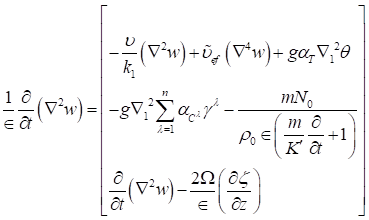|
|
|
|
Multi-diffusive Convection in a Rotating Porous Layer under the effects of Suspended Particles and Gravity Field: A Brinkman ModelRajan Singh 1 1 Department of Mathematics, IFTM University, Moradabad, 244001, India2 Department of Applied Mathematics, Government Polytechnic, Pilibhit, 262001, India |
|
||
|
|
|||
|
Received 09 March 2022 Accepted 10 April 2022 Published 26 April 2022 Corresponding Author Rajan Singh, rajan0779@rediffmail.com DOI 10.29121/ijetmr.v9.i4.2022.1135 Funding: This research
received no specific grant from any funding agency in the public, commercial,
or not-for-profit sectors. Copyright: © 2022 The
Author(s). This is an open access article distributed under the terms of the
Creative Commons Attribution License, which permits unrestricted use, distribution,
and reproduction in any medium, provided the original author and source are
credited.
|
ABSTRACT |
|
|
|
The onset of
multi-diffusive convection problem is analysed theoretically to include the
effects of suspended particles and rotation through a porous medium. In the
present paper, Brinkman model is considered for the porous medium. The
variations in fluid density are due to the variation in |
|
||
|
Keywords: Multi-Diffusive Convection, Suspended
Particles, Rotation, Brinkman Porous Medium 1. INTRODUCTION
Thermal convective instability of a horizontal layer of fluid heated
from below has several applications in geophysics, earth’s science,
oceanography, and extensive reviews of this subject can be found in Chandrasekhar (1981). Rayleigh (1916)
laid the foundation of the linear instability theory using small
infinitesimal perturbations. When two or more stratifying components (e.g.,
heat and salt diffusing at different rates) are present then the convective
phenomenon is termed as Double-diffusive or multi-diffusive convection having
extensive physical applications in ocean water, magmas, contaminant transport
and underground water flow. The flow through a porous medium has been of
fundamental importance in geothermal reservoirs, solidification, geothermal
power resources, astrophysics, chemical processing industry, petroleum
industry, recovery of crude oil from earth’s interior. A detailed study of
convection through a porous layer can be found in Nield and Bejan
(2006). The numerical and analytical treatment of the
double-diffusive and multi-diffusive convection saturating a porous layer is
reviewed in the references Huppert and Turner (1981), Turner (1985), Terrones and Pearlstein (1989), Tracey (1996), Straughan and Tracey (1999), Radko (2013), Rionero (2013a), Rionero (2013b), Prakash et al. (2016), |
|
||
Kumar et al. (2017).
Convective instability in a rotating frame has numerous applications in rotating machinery, food processing industry, centrifugal casting of metals and in thermal power plants (to generate electricity by rotation of turbine blades). Rudraiah (1986) considered the effect of rotation on linear and non-linear double-diffusive convective problem saturating a porous layer.
In geophysical context, the fluid is often not pure but may instead be permeated with dust particles. These suspended particles have scientific relevance in geophysics, chemical engineering, and astrophysics Mcdonnel (1978). Scanlon and Segel (1973) considered the effect of suspended particles on the onset of Bénard convection and found that the critical Rayleigh number was reduced solely because the heat capacity of the pure fluid was supplemented by that of the particles.
The intention of the present paper is to analyse theoretically the onset of thermal convection in a multi-diffusive fluid layer in the presence of suspended dust particles, uniform vertical rotation saturating a porous medium. Most research outcomes for porous medium flows are based on the Darcy model which gives appropriate results at small Reynolds number. Therefore, Darcy-Brinkman model is employed for porous medium which is considered physically more realistic than the usual Darcy model and also gave satisfactorily result at large Reynolds number and for high porosity porous medium by incorporating the inertial and viscous effects in addition to the usual Darcy model. The research on multi-component fluid layer through porous medium has notable geophysical relevance in real life and is increasing with the number of salts dissolved in it.
2. PROBLEM FORMULATION AND LINEAR STABILITY ANALYSIS
Consider an infinite horizontal Boussinesq fluid layer
permeated with dust particles lying in the region ![]() through a
Darcy-Brinkman porous medium under the effect of a uniform vertical rotation
through a
Darcy-Brinkman porous medium under the effect of a uniform vertical rotation![]() . Both the boundaries are maintained at uniform temperatures
. Both the boundaries are maintained at uniform temperatures ![]() and
and ![]() and uniform
and uniform ![]() concentrations
concentrations ![]() and
and![]() with gravity acting in vertical downward direction (Figure 1).
with gravity acting in vertical downward direction (Figure 1).
|
|
|
Figure 1 Geometrical sketch of the
physical problem |
The governing equations of motion and continuity for an incompressible Boussinesq (1903) fluid layer saturating a Darcy-Brinkman porous medium Brinkman (1947a) are as:
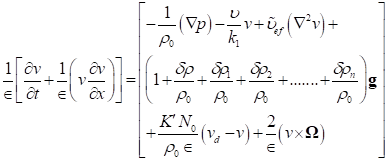
Equation 1
![]() Equation 2
Equation 2
where,![]() denote, respectively, the time, the reference density, fluid
density, effective porosity, pressure, kinematic viscosity, effective kinematic
viscosity, fluid velocity components, particles velocity, effective
permeability, number density of suspended particles and the gravitational
acceleration vector. The term
denote, respectively, the time, the reference density, fluid
density, effective porosity, pressure, kinematic viscosity, effective kinematic
viscosity, fluid velocity components, particles velocity, effective
permeability, number density of suspended particles and the gravitational
acceleration vector. The term![]() is the Stoke’s drag co-efficient.
is the Stoke’s drag co-efficient.
The presence of suspended particles adds an extra force term, in equation of motion, proportional to velocity difference between particles and fluid. Since the force exerted by the fluid on the particles is equal and opposite to that exerted by the particles on the fluid, there must be an extra force term, equal in magnitude but opposite in sign, in the equations of motion for the particles. Inter-particle reactions are ignored as the distances between the particles are assumed to be quite large compared with their diameters.
The governing equations of motion and continuity for the particles (ignoring the pressure, magnetic field, and gravity) are as:
![]() Equation 3
Equation 3
![]() Equation
4
Equation
4
where ![]() is the mass of particles per unit volume.
is the mass of particles per unit volume.
The equations for temperature field and solute concentrations are as:
 Equation 5
Equation 5
where, ![]() denote, respectively, the density of solid
material, heat capacity of solid material, the specific heat at constant
volume, heat capacity of suspended particles, the temperature, and the
coefficient of heat conduction.
denote, respectively, the density of solid
material, heat capacity of solid material, the specific heat at constant
volume, heat capacity of suspended particles, the temperature, and the
coefficient of heat conduction.
 Equation 6
Equation 6
The symbols![]() denote the analogous
denote the analogous![]() solute components.
solute components.
The density is taken as a linear function of temperature field and salt concentrations as:
![]() Equation
7
Equation
7
where, ![]() denote, respectively,
the temperature at lower boundary, temperature at upper boundary, coefficient
of thermal expansion, coefficients of solute expansion, concentration
components at lower and upper boundaries.
denote, respectively,
the temperature at lower boundary, temperature at upper boundary, coefficient
of thermal expansion, coefficients of solute expansion, concentration
components at lower and upper boundaries.
The basic state is assumed to be stationary and therefore, for determining the stability/instability of the system linear stability analysis procedure followed by normal mode method is adopted by introducing small infinitesimal perturbations in the basic variables.
The basic state of the system is defined as:
 Equation 8
Equation 8
Let the perturbations in the basic variables given in Equation 8 are defined as:
![]() Equation 9
Equation 9
So, the resulting linearized perturbation equations after eliminating the pressure gradient term are as:
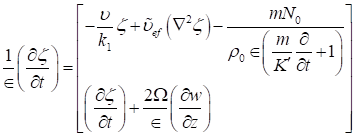 Equation 11
Equation 11
 Equation 12
Equation 12
The change in density ![]() due to temperature variation
due to temperature variation ![]() and concentration variations
and concentration variations![]() is given by
is given by
![]() Equation 14
Equation 14
where, in Equation 10, Equation 13 denote, respectively, the thermal diffusivity, the solute diffusivity, vertical component of fluid velocity, vertical component of suspended particles velocity, vertical component of vorticity, horizontal Laplacian operator and Laplacian operator, with
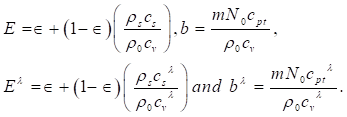
3.
NORMAL MODE METHOD AND DISPERSION RELATION
A normal mode representation is assumed in various
physical disturbances with a dependence on ![]() of the form:
of the form:
 Equation 15
Equation 15
where,![]() are the wave numbers along
are the wave numbers along![]() directions, respectively.
directions, respectively.
Using expression Equation 15, the non-dimensional form of Equation 10, Equation 13 (after dropping the asterisk for convenience) are as:
 Equation 16
Equation 16
![]() Equation 17
Equation 17
 Equation
18
Equation
18
The above perturbation equations (16)-(19) are non-dimensionalized using the following scaling’s:
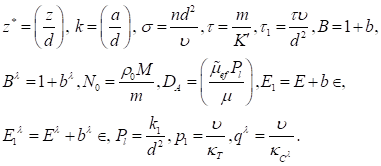
where,![]() is the dimensionless
medium permeability,
is the dimensionless
medium permeability,![]() is the thermal Prandtl
number,
is the thermal Prandtl
number, ![]() are the
are the ![]() Schmidt numbers,
Schmidt numbers, ![]() is the adverse temperature gradient,
is the adverse temperature gradient,![]() are the
are the ![]() solute concentration gradients,
solute concentration gradients, ![]() is a wave number and
is a wave number and ![]() is the frequency of
the harmonic disturbance and
is the frequency of
the harmonic disturbance and![]()
The boundary conditions (for the case of two free boundaries are defined as:
![]() Equation 20
Equation 20
Eliminating![]() from equations Equation 16, Equation 19 a dispersion relation
in
from equations Equation 16, Equation 19 a dispersion relation
in ![]() is obtained as:
is obtained as:
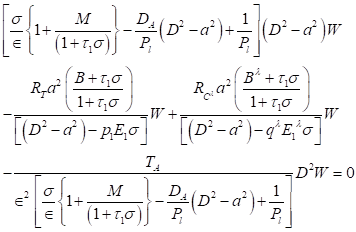 Equation 21
Equation 21
where,![]() (thermal Rayleigh
number),
(thermal Rayleigh
number), ![]() (solute Rayleigh
numbers),
(solute Rayleigh
numbers), ![]() (Taylor number).
(Taylor number).
4. THE STATIONARY CONVECTION
For stationary state![]() , Equation
21 yields an expression
of the form:
, Equation
21 yields an expression
of the form:
 Equation 22
Equation 22
Since all the even derivatives of![]() vanishes, so considering an appropriate solution for
vanishes, so considering an appropriate solution for ![]() of the form:
of the form:
![]()
Equation
 Equation 22 yields:
Equation 22 yields:
 Equation 23
Equation 23
where, the following notations are assumed as:
 Minimizing Equation
23 with respect to
Minimizing Equation
23 with respect to ![]() yields a fifth-degree equation in
yields a fifth-degree equation in ![]() as:
as:
![]() Equation
24
Equation
24
where,

The
critical dimensionless wave number![]() for varying
values of parameters can be obtained from Equation
24 and then the critical thermal and
solute Rayleigh numbers can be deduced from Equation
23.
for varying
values of parameters can be obtained from Equation
24 and then the critical thermal and
solute Rayleigh numbers can be deduced from Equation
23.
Equation
23 represents a relationship between
thermal and solute Rayleigh numbers in terms of various embedded parameters. The
effect of these parameters (suspended particles, medium permeability, medium
porosity, Taylor number, Darcy-Brinkman) on thermal Rayleigh number can be
examined analytically from the following derivatives ![]()
5.
CONCLUSION
A linear stability analysis followed by normal mode
method is taken into account to discuss the effect of uniform vertical rotation
and suspended particles on the onset of multi-diffusive convection through a
Darcy-Brinkman porous medium and a dispersion relation is obtained in terms of
thermal and solute Rayleigh numbers. Further, the case of stationary convection is also
discussed and a
relationship between thermal and solute Rayleigh numbers is obtained to study
the effect of various embedded parameters. The critical thermal and solute
Rayleigh numbers can be obtained with the help of critical dimensionless wave
number ![]() for varying
values of physical parameters.
for varying
values of physical parameters.
ACKNOWLEDGMENTS
One of the authors, Dr B.K. Singh, thanks the School of Science & Department of Mathematics, IFTM University, Moradabad-244001 (India), for financial support. Further, Dr B.K. Singh is for providing useful suggestions.
REFERENCES
Boussinesq, J. (1903). Theorie analytique de la Chaleur. Gauthier-Villars 2, 172. https://books.google.co.uk/books/about/Theorie_analytique_de_la_Chaleur.html?id=O08NmgEACAAJ&redir_esc=y
Brinkman, H.C. (1947a). A Calculation of The Viscous Force Exerted By A Flowing Fluid on A Dense Swarm of Particles. Applied Scientific Research, A1, 27-34. Https://Doi.Org/10.1007/BF02120313
Brinkman, H.C. (1947b). On The Permeability of Media Consisting of Closely Packed Porous Particles. Applied Scientific Research, A1, 81-86. Https://Doi.Org/10.1007/BF02120318
Chandrasekhar, S.C. (1981). Hydrodynamic and Hydromagnetic Stability. New York : Dover Publication. https://books.google.co.uk/books/about/Hydrodynamic_and_Hydromagnetic_Stability.html?id=oU_-6ikmidoC&redir_esc=y
Huppert, H., & Turner, J. (1981). Double-Diffusive Convection. Journal of Fluid Mechanics, 106, 299-329. Https://Doi.Org/10.1017/S0022112081001614
Kumar, K., Singh, V., Sharma, S. (2017). Effect of Horizontal Magnetic Field and Horizontal Rotation on Thermosolutal Stability of a Dusty Couple-Stress Fluid through a Porous Medium : à Brinkman Model. Journal of Applied Fluid Mechanics, 10(2), 681-692. Https://Doi.Org/10.18869/acadpub.jafm.73.239.27027
Mcdonnel J.A.M. (1978). Cosmic Dust. Toronto : John Wiley & Sons. https://www.abebooks.co.uk/9780471995128/Cosmic-Dust-MCDONNELL-JAM-0471995126/plp
Nield, D.A. And Bejan, A. (2006). Convection In Porous Media. New-York : Springer Science & Business Media. https://books.google.co.uk/books/about/Convection_in_Porous_Media.html?id=tG8sxSHrPEIC&redir_esc=y
Prakash, J., Singh, V., Kumar, R. And Kumari, K. (2016). The Onset of Convection In A Rotating Multicomponent Fluid Layer. Journal of Theoretical and Applied Mechanics, 54 (2), 477-488. Https://Doi.Org/10.15632/Jtam-Pl.54.2.477
Radko, T. (2013). Double-Diffusive Convection. Cambridge University Press. Https://Doi.Org/10.1017/CBO9781139034173
Rionero, S. (2013a). Multi-Component Diffusive-Convective Fluid Motions In Porous Layer Ultimately Boundedness, Absence of Subcritical Instabilities And Global Nonlinear Stability For Any Number of Salts. Physics of Fluids, 25, 1-23. Https://Doi.Org/10.1063/1.4802629
Rionero, S. (2013b). Triple Diffusive Convection In Porous Media, Acta Mechanics, 224, 447-458. Https://Doi.Org/10.1007/S00707-012-0749-2
Rudraiah, N., Shivakumara, I.S. And Friedrich, R. (1986). The Effect of Rotation on Linear And Non-Linear Double-Diffusive Convection In A Sparsely Packed Porous Medium. International Journal of Heat and Mass Transfer, 29(9), 1301-1317. Https://Doi.Org/10.1016/0017-9310(86)90163-8
Scanlon, J.W. And Segel, L.A. (1973). Some Effects of Suspended Particles on The Onset of Bénard Convection. The Physics of Fluids, 16, 1573-1578. Https://Doi.Org/10.1063/1.1694182
Straughan, B. And Tracey, J. (1999). Multi-Component Convection-Diffusion With Internal Heating And Cooling. Acta Mechanica, 133, 219-239. Https://Doi.Org/10.1007/BF01179019
Terrones, G. And Pearlstein, A.J. (1989). The Onset Of Convection In A Multicomponent Fluid Layer. The Physics of Fluids, 5(9), 2172-2182. Https://Doi.Org/10.1063/1.857381
Tracey, J. (1996). Multi-Component Convection-Diffusion In A Porous Medium, Continuum Mechanics and Thermodynamics, 8(6), 361-381. Https://Doi.Org/10.1007/S001610050050
Turner, J.S. (1985). Multicomponent Convection. Annual Review of Fluid Mechanics, 17, 11-44. Https://Doi.Org/10.1146/Annurev.Fl.17.010185.000303
|
|
 This work is licensed under a: Creative Commons Attribution 4.0 International License
This work is licensed under a: Creative Commons Attribution 4.0 International License
© IJETMR 2014-2022. All Rights Reserved.




